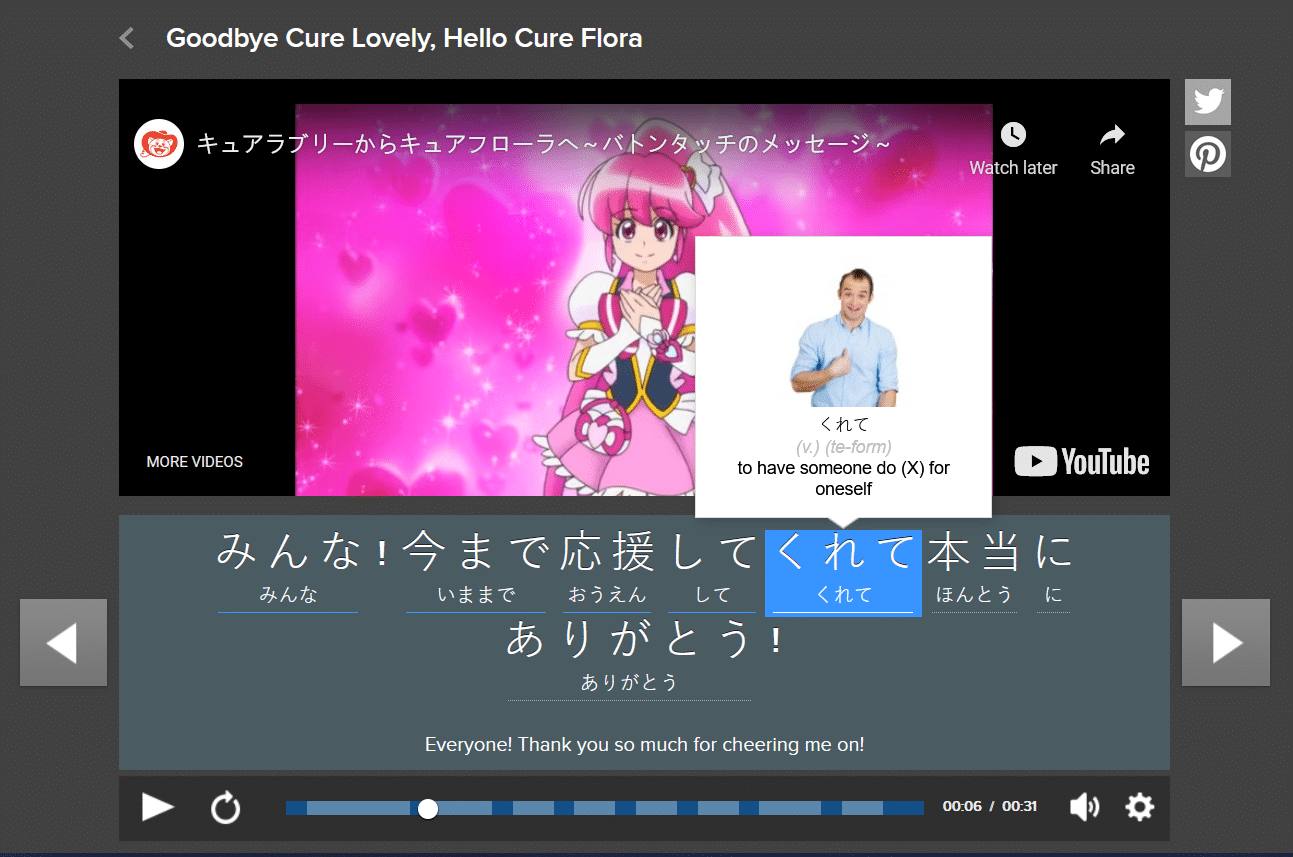Где можно посмотреть фильмы с японским дубляжом?
ФильмыДубляжСмотреть онлайн
Глеб Абубакиров
20 декабря 2020 · 309
Информационные системы и технологии, общепит. · 20 дек 2020
Способ 1: На японском языке вводите фильм в YouTube и смотрите.
Способ 2: Поставите другой поисковик рекомендую DuckDuckGo вводите всё на японском языке и ищите на просторах паутины.
Способ 3: торрент.
Если по каким либо причинам не открывается сайт или видео то VPN в помощь.
258
Комментировать ответ…Комментировать…

Japanese films / Фильмы на японском / 日本語の映画
405 subscribers
Зарубежные фильмы, дублированные на японский язык.
Movies dubbed into Japanese
Any questions?
Contact me:
https://t.me/just_simon22
View in Telegram
Preview channel
If you have Telegram, you can view and join
Japanese films / Фильмы на японском / 日本語の映画 right away.
Список раздач азиатского кино с русскими субтитрами в данном подфоруме и в подразделе Dorama и live-action
http://rutracker.org/forum/viewtopic.php?t=380626
Spiral / Спираль (фильм на японском языке с русскими субтитрам
http://www.loadbox.ru/film/157.html
Фильм на японском с русскими субтитрами – Норвежский лес (Noruwei no mori) – Япония, 2010г
http://lingua-dosug.livejournal.com/25023.html
http://www.loadbox.ru/films/cat8/
Изучение японского языка по фильмам с субтитрами
http://akusento.narod.ru/jimaku.htm
-
-
May 16 2010, 15:01
- Кино
- Cancel
где найти японский дубляж?
Пожалуйста, подскажите, есть ли все-таки японские торрент трекеры? Или где вообще можно скачать фильмы не японские, но с японским дубляжем? (к слову, мне нужен третий эпизод Звездных Войн)
p.s. про программы типа PD не пишите, у меня не пойдет, к сожалению
Спасибо большое!

By and Mike
Last updated:
December 20, 2022
Subtitles—a Japanese media lover’s best friend.
They can give your Japanese the boost it needs to eventually survive without them.
Whether you’re watching Japanese dramas, binging anime, enjoying a Japanese movie or anything in between, taking advantage of subtitles is the key to turning your favorite entertainment into quality learning material.
So let’s go through four techniques and eight resources you can use to learn more effectively using Japanese subtitles.
Contents
- Why Learn Japanese Through Entertainment and Subtitles?
- Learners of All Levels Can Learn with Japanese Subtitles
- A Potential Pitfall of Learning with Japanese Subtitles
- How to Find Dramas, Anime, Movies and More with Japanese Subtitles
- Where Can I Get Japanese Subtitles? 8 Resources You’ve Gotta Try
-
- Netflix
- FluentU
- Viki
- NYU Subtitles
- Kitsunekko
- Itazuraneko
- Project Modelino
- Asian Drama Wiki
- 4 Techniques for Learning with Japanese Subtitles
-
- 1. Simply Rewatch to Learn with Subtitles
- 2. Dissect the Japanese Subtitles and Master Every Word
- 3. Reverse Engineering: Use Japanese Subtitles to Translate the Dialogue Back to Japanese
- 4. Listen and Repeat: An Easy Method to Improve Your Speaking and Listening Through Japanese Subtitles
Download:
This blog post is available as a convenient and portable PDF that you
can take anywhere.
Click here to get a copy. (Download)
Why Learn Japanese Through Entertainment and Subtitles?
But before getting into the nitty-gritty, let’s talk about the benefits of learning Japanese with entertainment and subtitles—and why it’s worth your time.
- It’s fun! Some of the best dramas, TV shows, movies, etc. in the world are made in Japan. Dramas in particular tend to be short, around eleven episodes and emotionally intense. Not to mention extremely addictive!
- Another great thing about Japanese dramas is that the actors speak very clearly, and usually, only one person speaks at a time.
- Dramas feature useful, conversational language. This is the best way to learn things like aizuchi.
- Japanese media is a gateway to Japan’s culture. There are constantly new works that frequently tackle current cultural concerns or problems.
Learners of All Levels Can Learn with Japanese Subtitles
Many students at a beginner level feel intimidated by the thought of watching an episode and trying to understand the language.
But even if you understand very little, your ears will begin to pick out individual sounds, and you’ll start to hear a word now and then that you do know.
When you’re reading subtitles, you’re still listening at some level. Your mind will start to make connections between words that you see repeatedly and the sound of that particular word.
At an intermediate level, you’ll find that at times you don’t read the subtitles. But when you do, they’ll help your comprehension when you most need them to.
At this kind of proficiency, it can be hard to wean yourself off subtitles, and they really need to be turned off when possible. However, they’re still an essential tool for those times when a Japanese dialogue has become impenetrable.
Even an advanced speaker of Japanese will still use subtitles to catch the nuances of dialogue or just for the odd occasion when they hear something they don’t quite understand.
A Potential Pitfall of Learning with Japanese Subtitles
There’s one thing you should watch out for when learning with subtitles.
It can be extremely tiring to listen and try to understand a foreign language over a protracted amount of time. Gradually, you might stop actually hearing what the characters say and just read the subtitles.
When this happens, it’s easy to convince yourself that you’re still learning something, but you’re actually gaining nothing.
You might find yourself reading with your eyes rather than listening with your ears. If this happens, it’s best to stop watching and take a break.
To a certain extent, subtitles can become a crutch. If you find you can listen and follow what the different characters are saying, then turn off the subtitles. Don’t use them if you really don’t need them.
So, now that we’ve gotten that out of the way, how should we find these subtitles?
How to Find Dramas, Anime, Movies and More with Japanese Subtitles
There are many streaming sites where you can find the latest drama series with subtitles, such as Viki and Dailymotion.
And of course, there’s tons of subtitled content on YouTube. One great technique to search specifically for subtitled content is to add the phrases 字幕 (じまく)and セリフ集(せりふあつ)to the end of your search.
If you know the name of the drama, anime, movie, etc. you want to watch in English or Japanese, then you can usually find it on one of the above streaming sites.
And let’s not forget Netflix and the variety of anime sources!
If you want to learn with the subtitles themselves, then there are many “fansubbing” communities online where fans create and share the subtitles for popular shows. D-addicts is a popular one.
Where Can I Get Japanese Subtitles? 8 Resources You’ve Gotta Try
While Japanese subtitles can be tricky to find, a bit of sleuthing is all you need to dig them up.
That’s why I’m here to give you eight resources for Japanese subtitles to get you on your way to studying Japanese with the movies and shows you love!
Netflix

To the surprise of probably no one, Netflix is one of the premier resources for Japanese subtitles out there.
Many of Netflix’s Japanese programs offer subtitles in Japanese, with changing languages being as simple as tapping the subtitle icon in the bottom right-hand corner of the video.
Plus, you can lower the playback speed so you can catch every word that the actors are saying to match them to the subtitles.
Some Netflix titles with Japanese subs include: “Million Yen Women,” “Midnight Diner,” “Dad of Light” and “Scams.”
FluentU

FluentU is a language learning program that teaches Japanese through authentic videos. By “authentic videos,” I mean those that are made by and for native Japanese speakers, like anime clips, movie trailers, funny commercials, music videos and more.
These videos are subtitled in Japanese, with the option to turn romaji and English translations on, as well. All the subtitles are interactive: Hover over any word to see a definition. You can also click on words for a more detailed explanation and example sentences (vetted by professional translators) as well as other video clips where the word appears.
From here, you can add these words to custom flashcard decks and review them whenever you’re ready with FluentU’s personalized quizzes.
How does it work in practice? Well, for instance, you can watch a commercial for the anime “Princess Precure” and learn 20 new words and a few grammar points (like the te form).

You can use FluentU on the website, or download the iOS or Android app and keep learning from where you left off.
Viki

Want to watch the latest Japanese dramas with subtitles? You’ve come to the right place!
This service offers contemporary Japanese TV shows and movies, with a respectable library largely consisting of romantic comedies.
Viki is also aware that viewers may be trying to use their shows to acquire Japanese, so they’ve created a feature specifically for those studying Japanese: Learn Mode!
With Learn Mode, you get dual subtitles in Japanese and English. The video can be navigated in segments based on subtitle tracks, and you can even replay segments to ensure you’re understanding the line properly.
Why not try it out with shows like “Life: Love on the Line” or “When One Day I Will Sleep”?
NYU Subtitles
YouTube is another fantastic resource for Japanese subtitles.
This YouTube group has added subtitles to nearly 150 videos by Japanese comedian Atsuhiko Nakata from his channel Nakata University, where he teaches a variety of topics using comedy. Personally, I’m a fan of his videos on Japanese history!
Of course, there are a large number of YouTube channels that offer Japanese subtitles on their videos.
There are web series like “全力回避フラグちゃん”(ぜんりょくかいひふらぐちゃん, Utmost Evasion Flag-chan), about a shinigami who ends up saving the people she’s supposed to reap, and instructors like Moshi Moshi Yusuke, who teaches Japanese through his monologues as he takes viewers on tours of daily life in Japan.
Kitsunekko
Anime fans, you’re in luck: this is the go-to site for Japanese subtitles for anime.
Kitsunekko has a gigantic collection of subtitles for both contemporary and classic anime.
Whether you want to watch classics like “Ghost in the Shell,” contemporary hits like “The Promised Neverland” or something niche like “Golden Kamuy,” you’ll never run out of shows to watch subbed in their original language!
It’s worth noting that Kitsunekko, as well as the following websites, provide subtitle files, not the shows themselves.
To use them, download the .srt or .ass file you want and input them into a browser extension or subtitle program (such as Aegisub) to put on top of the shows you already have access to.
Itazuraneko
Like Kitsunekko, Itazuraneko offers a huge wealth of subtitles for Japanese movies and anime. You can search their page to find the show/movie you’re looking for to obtain the subtitle file.
Some show names are in Japanese, so make sure you have the Japanese title of the show you’re looking for during your search.
Project Modelino

Project Modelino offers subtitles for Japanese movies and a few TV shows. While the collection is a bit limited, the variety within it is nothing to sneeze at.
You can find Akira Kurosawa classics right alongside contemporary hits!
This site also walks you through the process of legally acquiring these movies and adding the Japanese subtitle files to them. Fantastic for newbies to the subtitle game!
Asian Drama Wiki
![]()
Managed by D-Addicts, Asian Drama Wiki is a true gold mine of fansubs for Japanese dramas.
While you need an account to access the subtitle index, subs are available for hundreds of shows.
Make sure to look carefully at how many episodes of each series have been subtitled as sometimes, episodes will be missing or the series is only partially complete.
If there happens to be a drama you have your eye on that doesn’t have Japanese subtitles yet, you can make a request in the forums.
Who knows, maybe a subbing group will pick it up!
4 Techniques for Learning with Japanese Subtitles
1. Simply Rewatch to Learn with Subtitles
One strategy can make a big difference in your Japanese learning experience.
This is to simply watch each episode with subtitles, to try and listen out for the grammar and vocabulary that’s used, and then to watch the episode again without subtitles.
When you watch the episode for a second time, you’ll notice that you remember the general gist of the conversations and the plot. The challenging part will be to listen and comprehend.
From your first viewing, you’ll have picked up some new vocabulary, as well as heard the words and grammar that you do know.
With this in mind, the first thing you need to do on your second viewing is to pick these out again plus the new vocabulary you heard previously.
You can build upon this by watching the same drama again and again. After enough viewings, you’ll find you can easily watch the episode without subtitles.
A special aspect of this is that Japanese dramas tend to only have eleven episodes, so if you can understand one episode, then you’re perfectly positioned to watch the other episodes with little preparation. You could even challenge yourself to watch the rest of the series without subtitles.
If your medium of choice isn’t a drama though—let’s say it’s an anime—try to either choose one with short episodes or split up long episodes into short chunks (say, 15-minute segments).
As for movies, the same rule applies. Don’t try to dissect the full movie in one sitting unless you’re looking for burnout and exhaustion.
2. Dissect the Japanese Subtitles and Master Every Word
It’s often not enough to just compare the Japanese subtitles and English translation.
To really master the words, you need to dissect the subtitles and study each word individually. This involves steps like:
- Looking words up in a good dictionary or thesaurus. This helps clarify the meaning. By using a thesaurus as well, you can discover similar words.
- Find good examples so you know how the words are used. It’s often not enough to just use the information provided in a dictionary. You need to get examples and kick the tires a bit.
- Input words and examples into flashcards. To increase your efficiency and be more systematic, you can create flashcards based on the dictionary and thesaurus. You can either do this online through an app and add your new vocabulary to your flashcard deck, or simply create a physical flashcard deck. For hardcore flashcard aficionados who use Anki and have some technical prowess, this open-source project called subs2srs might really speed up your learning process.
- Review words on a periodic basis with your flashcards. You need to be consistent with your review, and also systematic with scheduling words. You don’t want to spend too much time studying easy words, for example.
3. Reverse Engineering: Use Japanese Subtitles to Translate the Dialogue Back to Japanese
This method is an extremely good way of using subtitles, but it’s very challenging and time-consuming.
The combination of video, sound and English subtitles are weapons to be used, we just need to learn how to use them.
First, watch the episode, video or clip with subtitles to give you an idea about the plot, as well as what’s said in the dialogues and, more specifically, the kind of language that’s used.
The next step is to try and transcribe the dialogue, with the subtitles turned off, in Japanese. This will require repeated viewings and you’ll have to listen very carefully to get everything written down.
If you’re watching on a computer, you can take advantage of certain software to slow down the video so that you can hear every syllable.
Once you’re finished, you’ll have a transcription of the Japanese dialogue along with the video and audio to listen to, and the subtitles for reference so you understand how the Japanese content has been translated.
You can pick up a lot of vocabulary and grammar, see the differences between how different genders and generations speak and also gain an insight into the translation process.
4. Listen and Repeat: An Easy Method to Improve Your Speaking and Listening Through Japanese Subtitles
A very simple tactic you can use is to simply pick a scene, listen to the dialogue and repeat it out loud.
The subtitles provide you with the English meaning for what each character is saying so you don’t have to look it up.
Drama episodes take especially well to this method. Only one character tends to talk at any given moment, so you can usually hear very clear sentences that you can practice saying out loud.
If you can get to the point where you’re able to easily repeat the dialogue, you’ll find that you’re also making progress in your listening and speaking skills in general.
And there you have it—four techniques for using Japanese subtitles and eight resources to get you one step (or ten) closer to fluency!
By consistently using the methods listed above, you’ll find that your favorite Japanese media becomes easier to comprehend (with or without subtitles) by the day.
Download:
This blog post is available as a convenient and portable PDF that you
can take anywhere.
Click here to get a copy. (Download)
